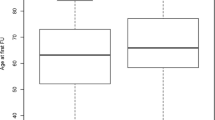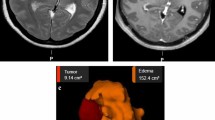Summary
The authors analysed the correlation between different clinical, radiological, and pathological variables and the presence and intensity of brain oedema associated to intracranial meningioma in 400 consecutive patients studied by computerized tomography (CT).
The following factors did not show significant correlation with brain oedema development: the age and sex of the patient, the occurrence of focal deficits, the presence of skull changes (endostosis, exostosis, osteolysis), the occurrence of tumour calcification, the density of the tumour on plain CT scan, the presence of a cystic component, the pathological subtype of meningioma (both conventional and non-conventional), and the presence of histological features of tumour aggressiveness, such as an increased vascularization, high cellularity, high mitotic index, pleomorphism, necrosis, and brain infiltration.
Factors showing a statistically significant correlation with the presence and intensity of brain oedema at the bivariate analysis were: the presence of symptoms (p < 0.001), the duration of the clinical history (p < 0.05), the location and size of the tumour (p < 0.001), the type (heterogeneous vs homogeneous), and intensity of tumour contrast enhancement (p < 0.001), the presence of irregular tumour margins (p < 0.001), and the existence of focal low density intratumoural areas (p < 0.001).
The multivariate analysis using only clinical parameters showed that the group of variables with the highest power for predicting the presence of brain oedema (concordance level of 76.8%) included: the presence of symptoms, the occurrence of seizures (focal or generalized), the presence of an intracranial hypertension syndrome, and the age of the patient. The multivariate analysis using only anatomico-radiological parameters showed that the model which included the size of the tumour, the intensity of contrast enhancement, the tumour margins, and meningioma location, predicted the presence of brain oedema in 80.8% of the cases.
Though the results of the present study do not definitively support any of the major physiopathological theories proposed to explain brain oedema formation in patients with intracranial meningioma, some findings could favour the so-called hydrodynamic theory.
Similar content being viewed by others
References
Alguacil-García A, Pettigrew NM, Sima AAF (1986) Secretory meningioma. A distinct subtype of meningioma. Am J Surg Pathol 10: 102–111
Alvarez F, Roda JM, Romero MP, Morales C, Sarmiento MA, Blazquez MG (1987) Malignant and atypical meningiomas: a reappraisal of clinical, histological and computed tomographic features. Neurosurgery 20: 688–694
Arienta C, Caroli F, Crotti F, Villani R (1990) Treatment of intracranial meningiomas in patients over 70 years old. Acta Neurochir (Wien) 107: 47–55
Atkinson JLD, Lane JI (1994) Frontal sagittal meningioma. Tumour parasitation of cortical vasculature as the etiology of peritumoral edema. J Neurosurg 81: 924–926
Benzel EC, Gelder FB (1988) Correlation between sex hormone binding and peritumoral edema in intracranial meningiomas. Neurosurgery 23: 169–174
Bradac GB, Ferszt R, Bender A, Schörner W (1986) Peritumoral edema in meningiomas. A radiological and histological study. Neuroradiology 28: 304–312
Brandis A, Mirzai S, Tatagiba M, Walter GF, Samii M, Ostertag H (1993) Immunohistochemical detection of female sex hormone receptors in meningiomas: correlation with clinical and histological features. Neurosurgery 33: 212–218
Cahill DW, Bashirelahi N, Solomon LW, Dalton T, Saloman M, Ducker T (1984) Estrogen and progesterone receptors in meningiomas. J Neurosurg 60: 985–993
Challa VR, Moody DM, Marshall RB, Kelly DL (1980) The vascular component in meningiomas associated with severe cerebral edema. Neurosurgery 7: 363–368
Challa VR (1987) Comments in: Maiuri F, Gangemi M, Cirillo S, Delehaye L, Gallicchio B, Carandete M, Giamundo A: Cerebral edema associated with meningiomas. Surg Neurol 27: 64–68
Casasco A, Mani J, Alachkar F, Jahara M, Théron J (1986) L'oedme peritumoral dans les méningiomes intracrâniens corrélation angiographique et tomodensitométrique. Neurochirurgie 32: 296–303
Ciric I (1988) Comments in GO KG, Wilmink JT, Molenaar WM: Peritumoral brain edema associated with meningiomas. Neurosurgery 23: 178–179
Constantini S, Tamir J, Gomori MJ, Shohami E (1993) Tumor prostaglandin levels correlate with edema around supratentorial meningiomas. Neurosurgery 33: 204–211
Crone KR, Challa VR, Kute TE, Moody DM, Kelly DL (1988) Relationship between flow cytometric features and clinical behaviour of meningiomas. Neurosurgery 23: 720–724
Gushing H, Eisenhardt L (1938) Meningiomas: their classification, regional behaviour, life history, and surgical end results. Thomas, Springfield
Dietemann JL, Heldt N, Burguet JL, Medjek L, Maitror D, Wackenheim A (1982) CT findings in malignant meningiomas. Neuroradiology 23: 207–209
Djindjian M, Caron JP, Athayde AA, Février MJ (1988) Intracranial meningiomas in the elderly (over 70 years old): a retrospective study of 30 surgical cases. Acta Neurochir (Wien) 90: 121–123
Donnell MS, Meyer GA, Donegan WL (1979) Estrogen-receptor protein in intracranial meningiomas. J Neurosurg 50: 499–502
Fine M, Brazis B, Palacios E, Neri G (1980) Computed tomography of sphenoid ridge meningiomas: tumor location related to distal edema. Surg Neurol 13: 385–390
Gado MH, Phelps ME, Coleman RE (1975) An extravascular component of contrast enhancement in cranial computed tomography. Part II: contrast enhancement and blood-tissue barrier. Radiology 117: 595–598
Gazendam J, Go KG, Van Zanten AK (1979) Composition of isolated edema fluid in cold-induced edema. J Neurosurg 51: 70–77
Gilbert JJ, Paulseth JE, Coates RK, Mallot D (1983) Cerebral edema associated with meningiomas. Neurosurgery 12: 599–605
Glick RP (1989) Comments in: Halper J, Colvard DS, Scheithauer BW, Jiang N, Press M, Grahan M, Riehl E, Laws E, Speiberg T: Strogen and progesterone receptors in meningiomas: comparison of nuclear binding, dextran-coated charcoal, and immunoperoxidase assays. Neurosurgery 25: 546–552
Go KG, Wilmink JT, Molenaar WM (1988) Peritumoral edema associated with meningiomas. Neurosurgery 23: 175–179
Go KG, Kamman RL, Wilmink JT, Mooyaart EL (1993) A study on peritumoral oedema around meningiomas by CT and MRI scanning. Acta Neurochir (Wien) 125: 41–46
Hino A, Imahori Y, Tenjin H, Mizukawa N, Ueda S, Hirakawa K, Nakahashi H (1990) Metabolic and hemodynamic aspects of peritumoral low-density areas in human brain tumors. Neurosurgery 26: 615–621
Hiyama H, Kubo O, Tajika Y, Takakura K (1994) Meningiomas associated with peritumoural venous stasis: three types on cerebral angiogram. Acta Neurochir (Wien) 129: 31–38
Inamura T, Nishio S, Takeshita I, Fujiwara S, Fukui M (1992) Peritumoral brain edema in meningiomas. Influence of vascular supply on its development. Neurosurgery 31: 179–185
Lanksch W, Baethmann A, Kazner E (1980) Computed tomography of brain edema, Adv Neurol 28: 67–98
Latchaw RE, Hirsch WL (1991) Computed tomography of intracranial meningiomas. In: Al-Mefty O (ed) Meningiomas. Raven, New York, pp 59–73
Lidley JG, Challa VR, Kelly DL (1991) Meningiomas and brain edema. In: Al-Mefty O (ed) Meningiomas. Raven, New York, pp 59–73
Long DM (1981) Comments in: Smith HP, Challa VR, Moody DM, Kelly DL: Biological features of meningiomas that determine the production of cerebral edema. Neurosurgery 8: 428–433
Maĺlo A, Dfaz P, Morales F, Hernandez J, Martín JA, Orfao A, Moyano JC (1994) Meningiomas intracraneales y edema cerebral. Estudio correlative de diverses factures etiopatogénicos. Neurocirugía 5: 204–210
Maiuri F, Gangemi M, Cirillo S, Delehaye L, Gallicchio B, Carandete M, Giamundo A (1987) Cerebral edema associated with meningiomas. Surg Neurol 27: 64–68
Meixensberger J, Caffier H, Naumann M, Hofmann E (1992) Sex hormone binding and peritumoural oedema in meningiomas: is there a correlation? Acta Neurochir (Wien) 115: 98–102
New PFJ, Aronow S, Hesselink JR (1980) National Cancer Institute Study: evaluation of computed tomography in the diagnosis of intracranial neoplasms. IV. Meningiomas. Radiology 136: 665–675
New PFJ, Hesselink JR, O'Carroll CP, Kleinman GM (1982) Malignant ineningioma: CT and histological criteria including a new CT sign. AJNR 3: 267–276
Philippen J, Foncin JF, Grob R, Srour A, Poisson M, Pertuiset BF (1984) Cerebral edema associated with meningiomas: possible role of a secretory-excretory phenomenon. Neurosurgery 14: 295–301
Ramamurthi B, Ravi R, Ramachandran V (1980) Convulsions with meningiomas: incidence and significance. Surg Neurol 14: 415–416
Reulen HJ, Graber S, Huber P, Ito U (1988) Factors affecting the extension of peritumoural brain oedema. A CT-study. Acta Neurochir (Wien) 95: 19–24
Russell DS, Rubinstein LJ (1989) Tumours of the meninges and related tissues. In: Russell DS, Rubinstein LJ (eds) Pathology of tumours of the nervous system, 5th Ed. Edward Arnold, London, pp 449–532
Russell EJ, George AE, Kricheff II, Budzilovich G (1980) Atypical computed tomographic features of intracranial meningioma. Radiological-pathological correlation in a series of 131 cases. Radiology 135: 673–682
Salpietro FM, Alafaci C, Lucerna S, Lacopino DG, Todaro C, Tomasello F (1994) Peritumoral edema in meningiomas: microsurgical observations of different brain tumor interfaces related to computed tomography. Neurosurgery 35: 638–642
Servo A, Porras M, Jääskenläinen J, Paetau A, Haltia M (1990) Computed tomography and angiography do not reliably discriminate malignant meningiomas from benign ones. Neuroradiology 32: 94–97
Shinonaga M, Chang CC, Suzuki N, Sato M, Kuwabara T (1988) Immunohistological evaluation of macrophage infiltrates in brain tumors. J Neurosurg 68: 259–265
Sigel RM, Messina AV (1976) Computed tomography: the anatomical basis of the zone of disminished density surrounded meningiomas. AJR 127: 139–141
Smith HP, Challa VR, Moody DM, Kelly DL (1981) Biological features of meningiomas that determine the production of cerebral edema. Neurosurgery 8: 428–433
Stevens JM, Ruiz JS, Kendall BE (1983) Observation on peritumoural oedema in meningioma. Part 1: distribution, spread and resolution of vasogeneric oedema seen on computed tomography. Neuroradiology 25: 71–80
Stevens JM, Ruiz JS, Kendall BE (1983) Observation on peritumoural oedema in meningioma. Part 2: Mechanisms of oedema production. Neuroradiology 25: 125–131
Tatagiba M, Mirzai S, Samii M (1991) Peritumoral blood flow in intracranial meningiomas. Neurosurgery 28: 400–404
Vassilouthis J, Ambrose J (1979) Computerized tomography scanning appearances of intracranial meningiomas. J Neurosurg 50: 320–327
Vries J, Wakhloo AK (1993) Cerebral oedema associated with WHO-I, WHO-II, and WHO-III meningiomas: correlation of clinical, computed tomography, operative and histological findings. Acta Neurochir (Wien) 125: 34–40
Author information
Authors and Affiliations
Rights and permissions
About this article
Cite this article
Lobato, R.D., Alday, R., Gómez, P.A. et al. Brain oedema in patients with intracranial meningioma. Acta neurochir 138, 485–494 (1996). https://doi.org/10.1007/BF01411166
Issue Date:
DOI: https://doi.org/10.1007/BF01411166




